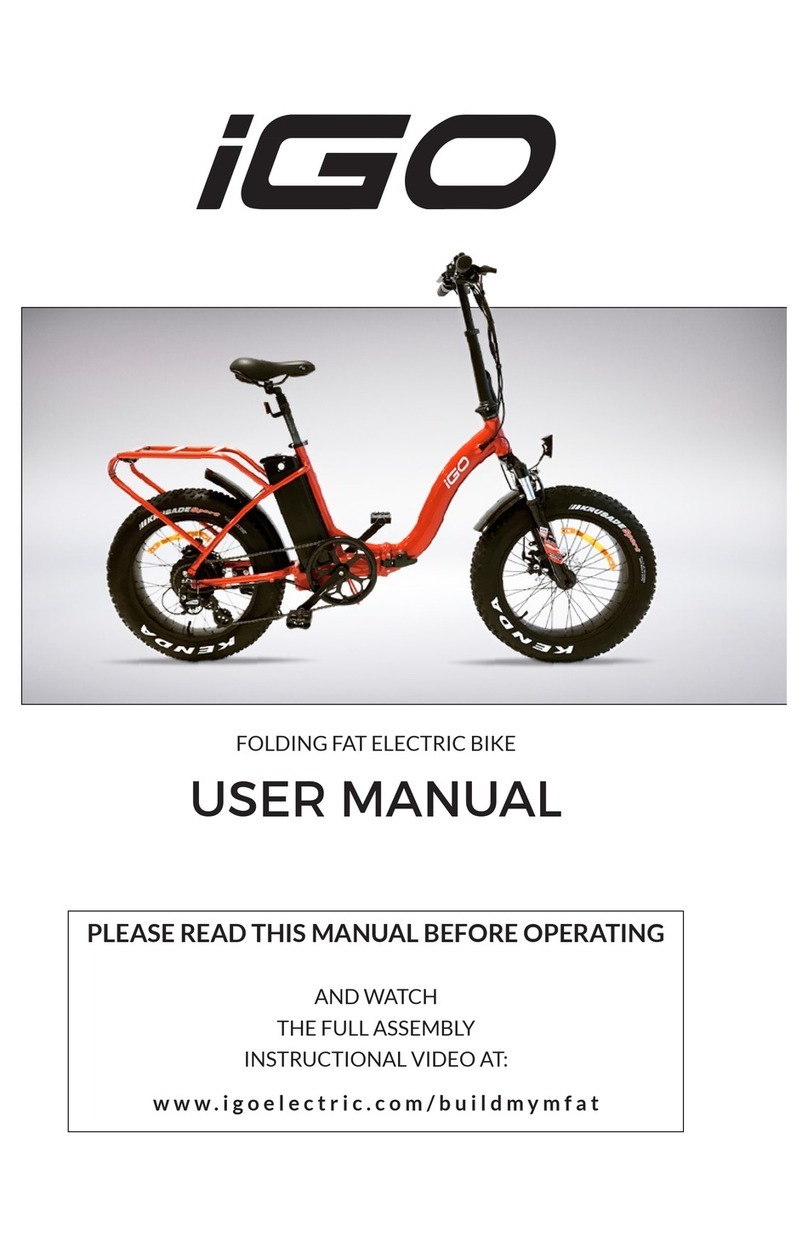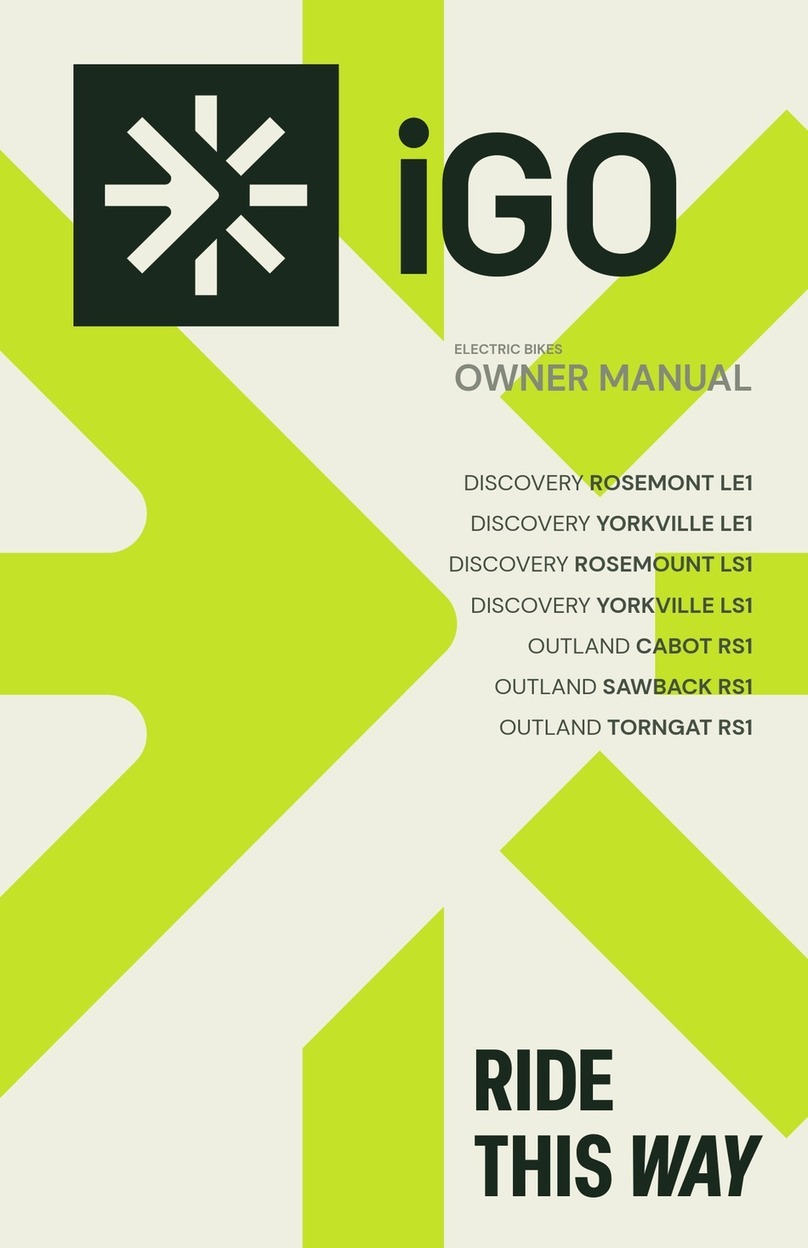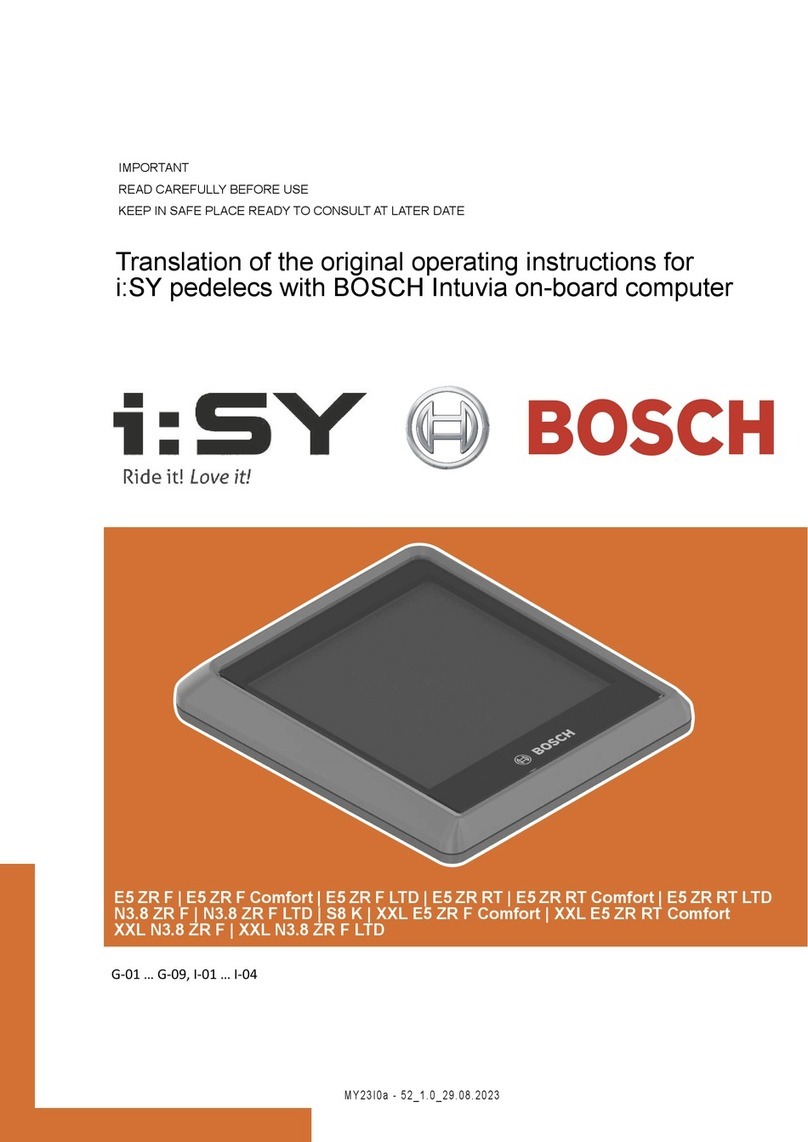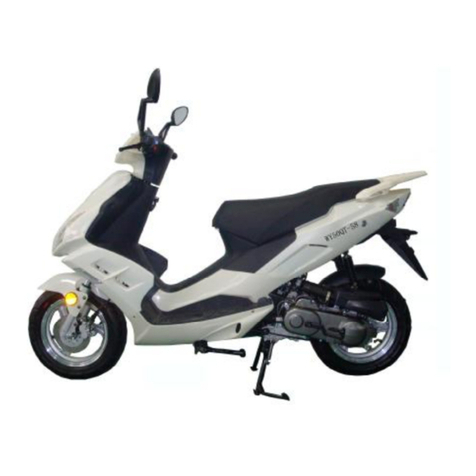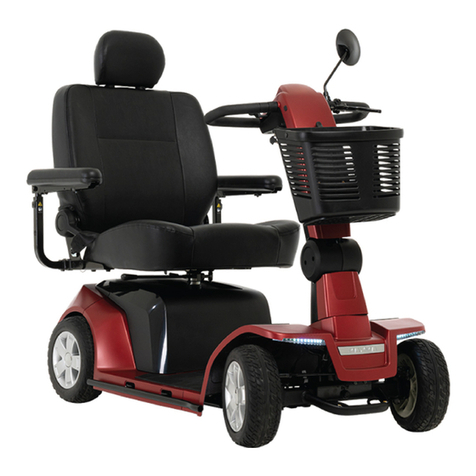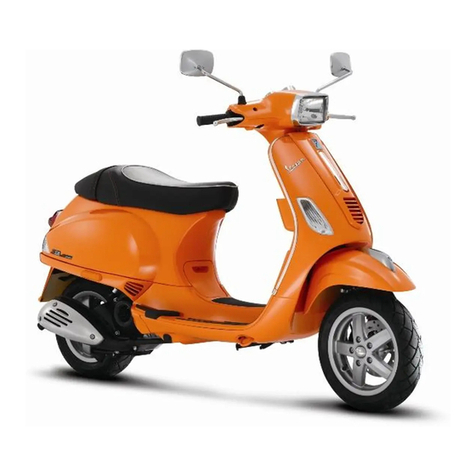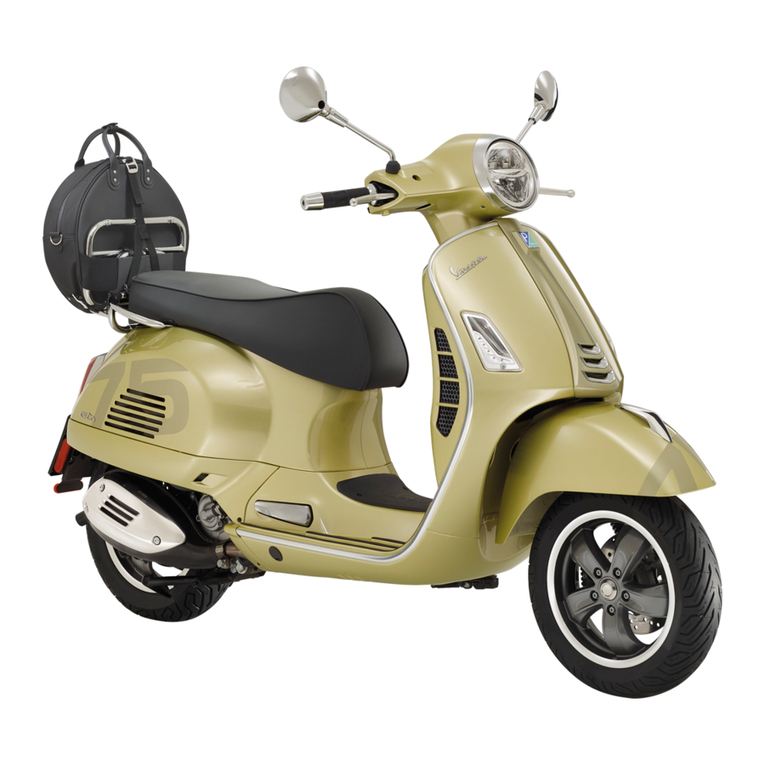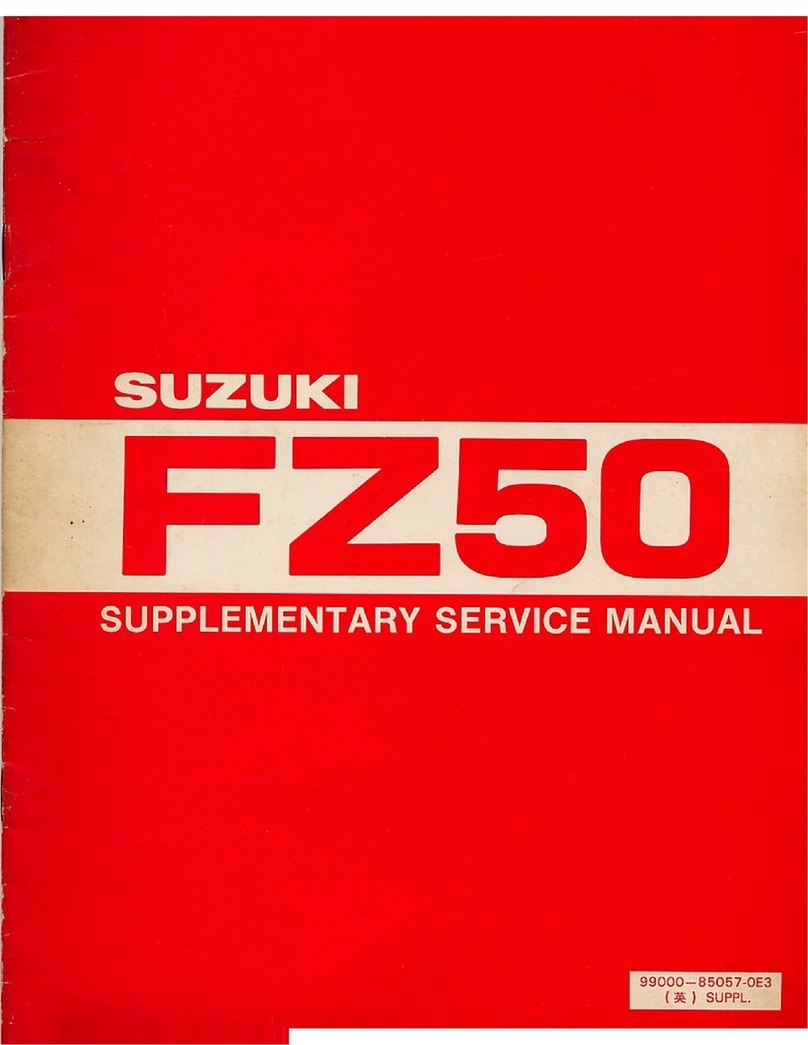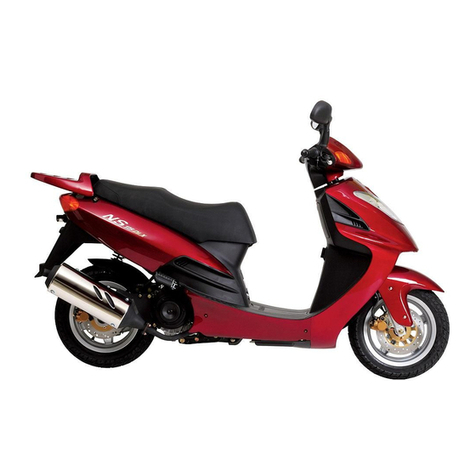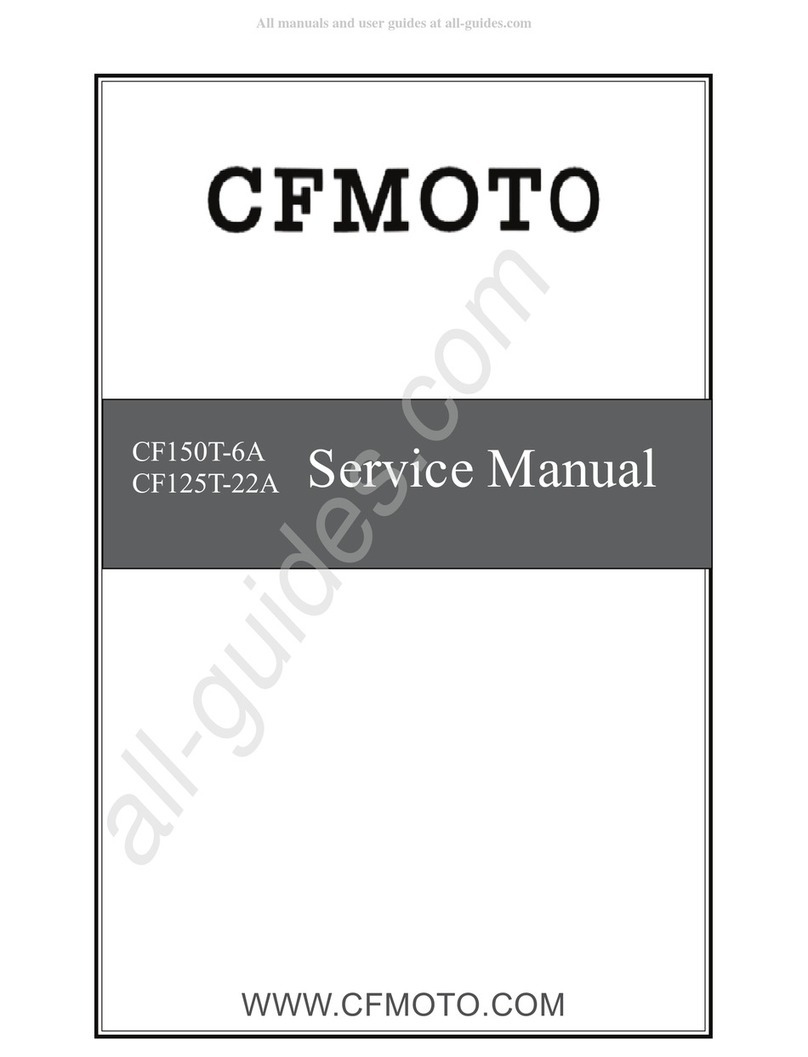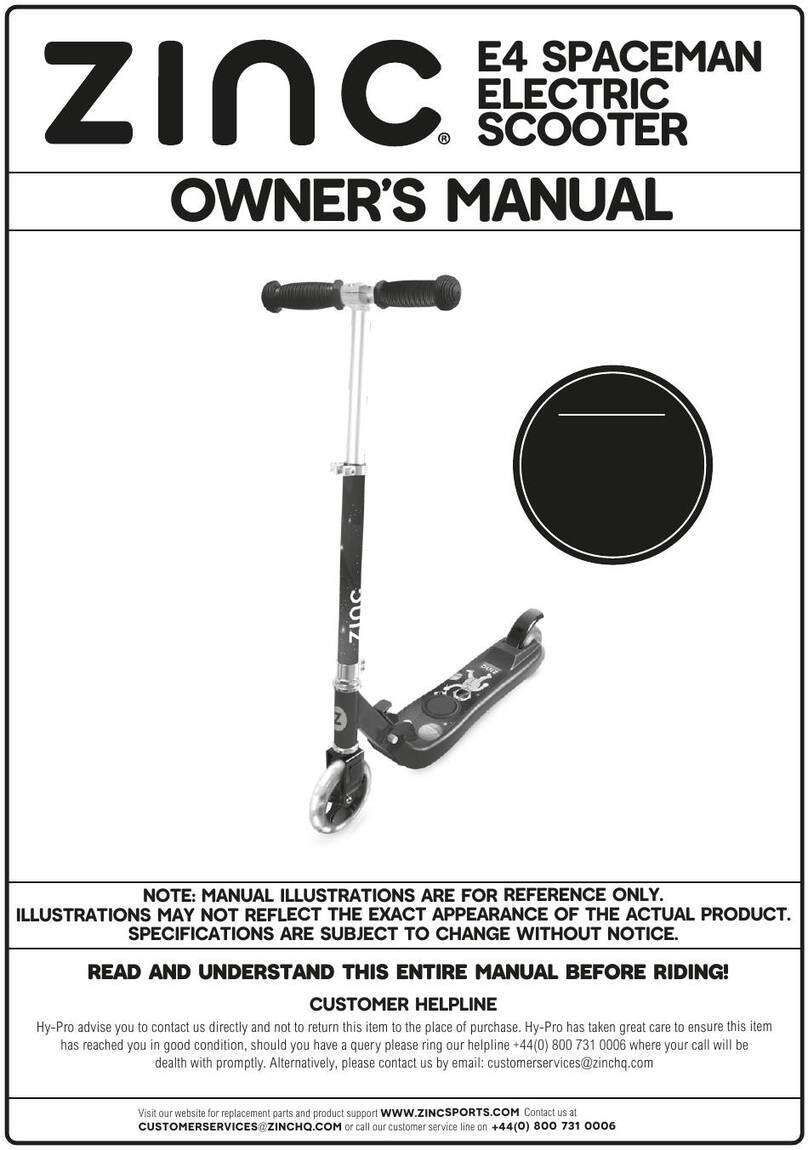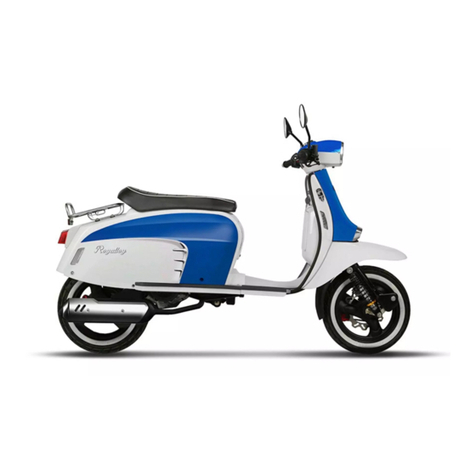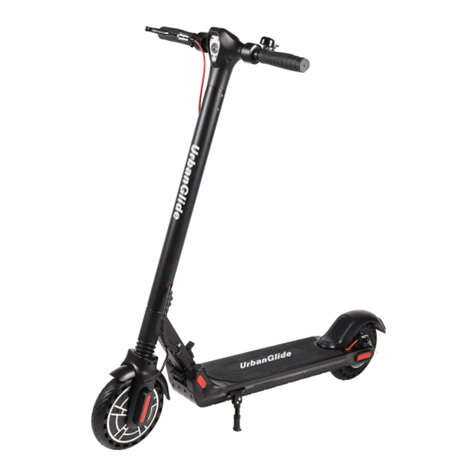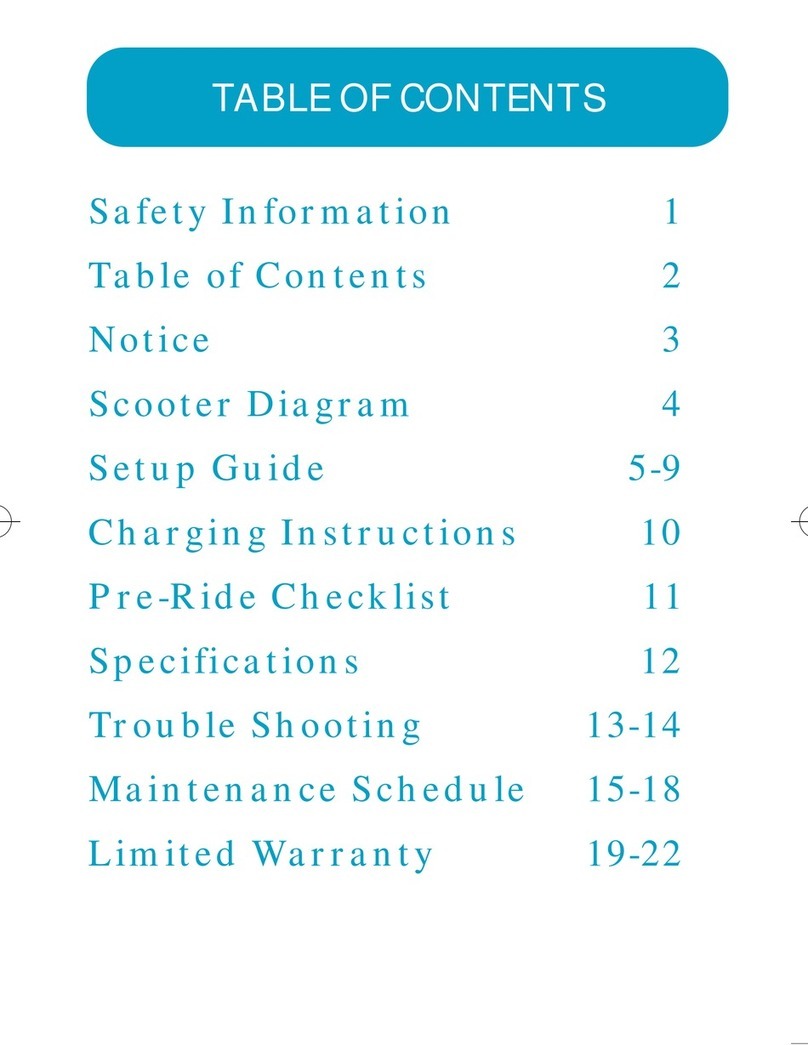I-GO S20 User manual

Serial #/série #/serie #
Please fi ll out the following information for quick reference:
S.V.P. veuillez compléter les informations ci dessous:
Por favor, rellene la siguiente información para tener siempre a mano:
Dealer:
Marchand:
Comerciante:
Address:
Adresse:
Dirección:
Telephone:
Téléphone:
Número de teléfono:
Purchase Date:
Date d’achat:
Fecha de compra:

4
Copyright © 2022
INFMANU5131/Rev B/September 2022
The intended use of this Pride Mobility Products scooter is to provide mobility assistance to persons
who have the capacity to operate a motorized mobility product for recreational use.
NOTE: This owner’s manual is compiled from the latest specifi cations and product information available at
the time of publication. We reserve the right to make changes as they become necessary. Any changes to our
products may cause slight variations between the illustrations and explanations in this manual and the product
you have purchased. The latest/current version of this manual is available on our website.
NOTE: This product is compliant with WEEE, RoHS, and REACH directives and requirements.
NOTE: This product meets IPX4 classifi cation (IEC 60529).
NOTE: The scooter and its components are not made with natural rubber latex. Consult with the manufacturer
regarding any after-market accessories.
NOTE: This product is not a medical product and is not intended to assist, treat, diagnose or alleviate any
medical condition or disability.
S A F E T Y G U I D E L I N E S
Language Usage
This owner’s manual is intended for distribution in all English-speaking countries where our scooters are sold. We
have chosen to compose this manual using language and spellings common to the USA. Since we recognize that
not all English-speaking countries use the same words or spellings, please refer to the following chart for some
common word variations that may be encountered throughout this manual.
USA Variation USA Variation USA Variation
E N

i-Go™ 3
E N
C O N T E N T S
SAFETY GUIDELINES ............................................................................................. 2
INTRODUCTION ...................................................................................................... 4
I. SAFETY ........................................................................................................... 5
II. YOUR SCOOTER ............................................................................................. 7
III. BATTERIES AND CHARGING ........................................................................ 10
IV. OPERATION .................................................................................................. 16
V. DISASSEMBLY/ASSEMBLY AND FOLDING/UNFOLDING ........................... 17
VI. BASIC TROUBLESHOOTING ........................................................................ 21
VII. CARE AND MAINTENANCE .......................................................................... 22
S A F E T Y G U I D E L I N E S
WARNING! An authorized Dealer or qualifi ed technician must perform the initial setup of this
scooter and must perform all of the procedures in this manual.
The symbols below are used throughout this owner’s manual and on the scooter to identify warnings and important
information. It is very important for you to read them and understand them completely.
WARNING! Indicates a potentially hazardous condition/situation. Failure to follow designated
procedures can cause either personal injury, component damage, or malfunction. On the
product, this icon is represented as a black symbol on a yellow triangle with a black border.
MANDATORY! These actions should be performed as specifi ed. Failure to perform mandatory
actions can cause personal injury and/or equipment damage. On the product, this icon is
represented as a white symbol on a blue dot with a white border.
PROHIBITED! These actions are prohibited. These actions should not be performed at any
time or in any circumstances. Performing a prohibited action can cause personal injury and/or
equipment damage. On the product, this icon is represented as a black symbol with a red circle
and red slash.
CALIFORNIA PROPOSITION 65 WARNING! This product may contain substances which are
known to the state of California to cause cancer and birth defects or other reproductive harm.
For more information, go to www.P65Warnings.ca.gov.

4 i-Go™
E N
I N T R O D U C T I O N
SAFETY
The scooter you have purchased combines state-of-the-art components with safety, comfort, and styling in mind.
We are confi dent that these design features will provide you with the conveniences you expect during your daily
activities. Once you understand how to safely operate and care for your scooter, it should give you years of trouble
free operation and service.
Read and follow all instructions, warnings, and notes in this manual before attempting to operate your scooter for
the fi rst time. You must also read all instructions, warnings, and notes contained in any supplemental instructional
booklets before initial operation. Your safety depends upon you using good judgment.
If there is any information in this manual which you do not understand, or if you require additional assistance for
setup or operation, please contact your authorized Dealer. Failure to follow the instructions in this manual and
those located on your scooter can lead to personal injury and/or damage to the scooter, including voiding
the warranty.
PURCHASER’S AGREEMENT
By accepting delivery of this product, you promise that you will not change, alter, or modify this product or
remove or render inoperable or unsafe any guards, shields, or other safety features of this product; fail, refuse, or
neglect to install any retrofi t kits from time to time provided to enhance or preserve the safe use of this product.
SHIPPING AND DELIVERY
Before using your scooter, make sure your delivery is complete as some components may be individually packaged.
If you do not receive a complete delivery, please contact your authorized Dealer immediately. Where damage has
occurred during transport, either to the packaging or content, please contact the delivery company responsible.
NOTE: If you ever lose or misplace your copy of this manual, contact us and we will be glad to send you a new
one immediately.

i-Go™ 5
E N
Fully charge batteries before operating.
Remove key from an unattended scooter.
Read and follow the information in this owner’s manual.
I . S A F E T Y
Scooter information label
PRODUCT SAFETY SYMBOLS
The symbols below are used on the scooter to identify warnings, mandatory actions, and prohibited actions. It is
very important for you to read and understand them completely.
NOTE: There are more warnings identifi ed and explained in the Consumer Safety Guide that is included with
your scooter. Please become familiar with all the warnings and safety information found in the Consumer
Safety Guide and refer to this resource often.
or Manufactured in
Does not meet ISO 7176-19 standards for occupied
transport in a motor vehicle. When travelling in a motor
vehicle, do not sit in your scooter.
or or

6 i-Go™
E N
I . S A F E T Y
GENERAL
MANDATORY! Do not operate your new scooter for the fi rst time without completely reading and
understanding this owner’s manual.
Your scooter is a state-of-the-art, life-enhancement product designed to increase mobility. We provide an extensive
variety of products to best fi t the individual needs of the scooter user. Please be aware that the fi nal selection and
purchasing decision regarding the type of scooter to be used is the responsibility of the scooter user, who is
capable of making such a decision.
WARNING! The i-Go™ is not intended for use by persons who cannot support themselves in an
upright position.
WARNING! Prior to operating your scooter, familiarize yourself with the location and use of
controls, including the tiller for steering and the throttle for accelerating. During operation,
keep both hands on the tiller at all times to assure safe operation of the scooter. Failure to
release the throttle when stopping the scooter can result in collision with people or objects
which may result in property damage, personal injury or death.
The following are precautions, tips, and other safety considerations intended to help you become accustomed
to operating your scooter safely. While we recognize that scooter users will frequently develop skills to manage
daily activities that may diff er from those illustrated in this manual, it is imperative that all safety guidelines in
this manual be followed to ensure user safety. Failure to follow the safety notices in this and other manufacturer-
supplied manuals and those located on your scooter can lead to personal injury and/or damage to the scooter, and
may result in voiding the product warranty.
PRE-RIDE SAFETY CHECK
Get to know the feel of your scooter and its capabilities. We recommend that you perform a safety check before
each use to make sure your scooter operates smoothly and safely.
Perform the following inspections prior to using your scooter:
Check the condition of the tires. If applicable, make sure they are properly infl ated and not damaged or
excessively worn.
Check all electrical connections. Make sure they are tight and not corroded.
Check all harness connections. Make sure they are secured properly.
Check the brakes to ensure they operate properly.
Check the battery condition meter to ensure the batteries are fully charged.
Ensure the manual freewheel lever is in drive mode before sitting on the scooter.
WARNING! Ensure the seat is fully raised and secured in driving position prior to sitting on your
scooter. Failure to do so may result in property damage and/or personal injury.
If you discover a problem, contact your authorized Dealer for assistance. Please refer to the Contact Information
insert in your Owner’s Package.
Braking Information
Scooters are equipped with two powerful brake systems—regenerative and disc park brake. Regenerative braking
uses electricity to rapidly slow the scooter to a neutral state. Disc park braking activates mechanically after
regenerative braking slows the vehicle to near stop, or when power is removed from the system for any reason.
Unless equipped with a specialty product, the speed of your scooter is controlled by a throttle control lever. When
the throttle control lever is moved from the center (neutral) position, an electronic signal is sent to the braking
system. The signal causes the electromagnetic brakes to release, allowing the vehicle to move. The more pres-
sure applied to the throttle control lever, the faster the vehicle will move up to a preset maximum speed. When
the throttle control lever is released back to the center (neutral) position, the electronic signal is reversed and the
electromagnetic brakes engage, allowing the scooter to decelerate to a stop.

i-Go™ 7
E N
I I . YO U R S C O O T E R
Figure 1. Tiller Console
TILLER CONSOLE
The tiller console houses all controls needed to drive your scooter, including the battery condition meter and
throttle. See fi gure 1.
PROHIBITED! Do not expose the tiller console to moisture. In the event that the tiller console
does become exposed to moisture, do not attempt to operate your scooter until the tiller console
has dried thoroughly.
IDENTIFICATION KEY
NOTE: Before initial use, the battery must be activated. For activation instructions, see III “Batteries and
Charging”/IV “Operation.”
Key Switch
Insert the key into the key switch and turn it clockwise to power up (turn on) your scooter.
Turn the key counterclockwise to power down (turn off ) your scooter.
Throttle Control Lever
This lever allows you to control the forward speed and the reverse speed of your scooter.
To use throttle control lever:
To move Forward, use your right thumb to push the right side of the throttle control lever.
To move Rearward, use your left thumb to push the left side of the throttle control lever.
Lights Switch
This switch controls your scooter’s lighting system.
Toggle the switch forward to turn on the lighting system.
Toggle the switch rearward to turn off the lighting system.
1. Mirror and Mirror Plug
2. HI-Low Switch
3. Battery Condition Meter
4. Horn
5. Key Switch
6. Throttle
7. USB Charger
8. Light Switch

8 i-Go™
E N
Hi-Low Switch
This switch toggles the scooter’s speed between Hi and Low.
Toggle the switch forward (Hi) to achieve the maximum
preprogrammed speed for the scooter. Toggle the switch
rearward (Low) to achieve half the maximum preprogrammed
speed of the scooter.
Battery Condition Meter
When the key switch is engaged to power up your scooter,
this meter indicates the approximate battery voltage strength
on your tiller display. For further information on battery
charging, see III. “Batteries and Charging.”
Drivetrain Assembly
The drivetrain assembly is an electromechanical unit that
converts electrical energy from your scooter’s batteries into the
controlled mechanical energy that drives the scooter’s wheels.
Battery Pack
Your scooter is equipped with an innovative easy-to-remove
Lithium-Ion battery pack. Refer to III. “Batteries and
Charging” for battery pack replacement instructions. See
fi gures 2 and 3.
Main Circuit Breaker (Reset Button)
When the voltage in your scooter’s batteries becomes low or
the scooter is heavily strained because of excessive loads or
steep inclines, the main circuit breaker may trip to protect the
motor and electronics from damage. See fi gure 3.
The main circuit breaker reset button pops out when the
breaker trips.
When the breaker trips, the entire electrical system of
your scooter shuts down.
Turn key switch off .
Allow a minute or two for your scooter’s electronics to
“rest.”
Push in the reset button towards the rear of the scooter to
reset the main circuit breaker.
If the main circuit breaker trips frequently, you may need
to charge your batteries more often.
If the main circuit breaker trips repeatedly, see your
authorized Dealer for service.
I I . YO U R S C O O T E R
Figure 2. Battery Pack
IDENTIFICATION KEY
1. XLR Connector
2. Battery Connector
3. LED Charge Display Button
4. LED Charge Dislpay
IDENTIFICATION KEY
1. Circuit Breaker
2. Battery Pack
3. XLR Port
Figure 3. Main Circuit Breaker

i-Go™ 9
E N
I I . YO U R S C O O T E R
Charger Power Cord Receptacle
The 3-pin end of the charger power cord plugs into this
receptacle. See fi gure 4.
Off-Board Battery Charger
The off -board battery charger, when plugged into the charger
power cord receptacle and a standard electrical outlet,
charges the scooter’s batteries. See fi gure 4.
Manual Freewheel Lever
Whenever you need or want to push your scooter for short
distances, you can put it in freewheel mode.
1. Remove the key from switch.
2. Push circuit breaker button towards front of scooter.
3. Locate the manual freewheel lever near the front wheel.
See fi gure 5.
4. Push downward on the manual freewheel lever to disable
the drive system and the brake system. You may now
push your scooter.
5. Pull the manual freewheel lever upward to reengage the
drive and the brake systems; this takes your scooter out
of freewheel mode.
WARNING! When your scooter is in freewheel
mode, the braking system is disengaged.
Disengage the drive motors only on a
level surface.
Ensure the key is removed from the key
switch.
Stand to the side of the scooter to
engage or disengage freewheel mode.
Never sit on a scooter to do this.
After you have fi nished pushing your
scooter, always return it to the drive
mode to lock the brakes.
IDENTIFICATION KEY
1. Manual Freewheel Lever
Figure 5. Freewheel Lever
Figure 4. Off-board Battery Charger

10 i-Go™
E N
I I I . B AT T E R I E S A N D C H A R G I N G
BATTERIES AND CHARGING
Your scooter requires one Lithium-Ion battery box that is sealed and maintenance-free. It is recharged by the
supplied off board charging system.
Charge your scooter’s battery prior to using it for the fi rst time. Fully charge your scooter’s battery using the charger
supplied with the scooter. Plug the charger into your scooter fi rst and then plug the charger into electrical an outlet.
Keep the battery fully charged to keep your scooter running smoothly.
CHARGING YOUR BATTERY
PROHIBITED! Removal of grounding prong can create electrical hazard. If necessary, properly
install an approved 3-pronged adapter to an electrical outlet having 2-pronged plug access.
PROHIBITED! Never use an extension cord to plug in your battery charger. Plug the charger
directly into a properly wired standard electrical outlet.
PROHIBITED! Do not allow unsupervised children to play near the scooter while the battery
is charging. We recommend that you do not charge the battery while the scooter is occupied.
MANDATORY! Read the battery charging instructions in this manual and in the manual supplied
with the battery charger before charging the battery.
WARNING! Explosive gases may be generated while charging the battery. Keep the scooter
and battery charger away from sources of ignition such as fl ames or sparks and provide
adequate ventilation when charging the battery.
WARNING! You must recharge your scooter’s battery with the supplied offboard charger. Do
not use another battery charger.
WARNING! Inspect the battery charger, wiring, and connectors for damage before each use.
Contact your authorized Dealer if damage is found or suspected to be damaged.
WARNING! Do not attempt to open the battery charger case. If the battery charger does not
appear to be working correctly, contact your authorized Dealer.
AMBIENT VOLTMETER
The battery condition meter on the tiller console indicates the approximate strength of your batteries using a color
code. From right to left on the meter, green indicates fully charged batteries, yellow a draining charge, and red
indicates that an immediate recharge is necessary. See fi gure 6 (1b). To ensure the highest accuracy, the battery
condition meter should be checked while operating your scooter at full speed on a dry, level surface.
NOTE: Scooters are equipped with an ambient light sensing battery condition meter that automatically adjust
brightness based on environment lighting.
READING YOUR BATTERY VOLTAGE
DOT MATRIX VOLTMETER
The LED display that is part of the battery condition meter
on the tiller console indicates the approximate remaining
percentage of your battery charge. At full charge, the icon will
read FL, indicating a fully charged battery. With continued
use, the LED display will display decreasing numbers as your
charge drains. Once the LED display reaches 10% battery
life, it will read LO, and an immediate recharge is necessary.
See fi gure 6 (1a). To ensure the highest accuracy, the battery
condition meter should be checked while operating your
scooter at full speed on a dry, level surface. Figure 6. Battery Condition Meter

i-Go™ 11
E N
To safely charge your Lithium-Ion battery:
1. Place your scooter next to an electrical outlet. See fi gure 8.
2. Remove the key.
3. Ensure that the scooter is in drive mode. See fi gure 5.
4. Connect the supplied 3-pin XLR Lithium-Ion charger into the 3-pin charging port on the scooter.
5. Plug the charger power cord into the wall electrical outlet. See fi gure 8.
6. Wait two (2) minutes. Two (2) red LED lights on the charger signify that charging has begun.
7. The batteries are fully charged when the LED on the battery charger is green.
NOTE: If the steps above were not performed in the correct order, unplug the charger cord from both the wall
electrical outlet and the scooter, wait one (1) minute, and then repeat the steps above in the order shown.
8. Unplug the battery charger from the scooter and electrical outlet.
WARNING! If the battery charger is equipped with cooling slots, then do not attempt to
insert objects through these slots.
WARNING! Be aware that the battery charger case may become hot during charging. Avoid
skin contact and do not place on surfaces that may be affected by heat.
WARNING! Do not attempt to operate your scooter with depleted batteries, as you may
become stranded.
WARNING! Battery chargers are not suitable to be used by children.
WARNING! If your battery charger has not been tested and approved for outdoor use,
then do not expose it to adverse or extreme weather conditions. If the battery charger
is exposed to adverse or extreme weather conditions, then it must be allowed to adjust
to the difference in environmental conditions before use indoors. Refer to the manual
supplied with the battery charger for more information.
I I I . B AT T E R I E S A N D C H A R G I N G
Follow the easy steps in fi gure 7 to charge your batteries safely:
Figure 7. Battery Charging Procedures Diagram

12 i-Go™
E N
I I I . B AT T E R I E S A N D C H A R G I N G
WARNING! Do not touch hot surface.
Persons who have sensitivity challenges
must take additional precautions to
prevent touching hot surfaces of the
charger.
WARNING! The battery charger may
have indicator lights that illuminate
under certain conditions. Refer to the
operating instructions supplied with the
charger for a complete explanation of
these indicators.
NOTE: There is a charger inhibit function on your
scooter. The scooter will not run and the battery condition
meter will not operate while the battery is charging (when
the battery pack is being charged on the scooter).
FREQUENTLY ASKED QUESTIONS
How does the charger work?
Refer to the manual supplied with the battery charger for
charging instructions.
Can I use a diff erent charger?
No. Any charging method using any other charger than the
one supplied with your scooter is especially prohibited.
What if my scooter’s battery will not charge?
Ensure that the 3-pin XLR charger is plugged into the
3-pin charging port on the scooter fi rst. Then plug the
power cord into the wall electrical outlet.
If equipped, ensure that the fuse on the battery is in
working condition.
Ensure both ends of the charger power cord are inserted
fully.
Ensure the charge LED, located on the charger, is
operating as indicated in the charger manual.
Figure 8. Battery Charging
How often must I charge the battery?
Two major factors must be considered when deciding how often to charge your scooter’s battery:
All day use on a daily basis.
Infrequent or sporadic use.
With these considerations in mind, you can determine how often and for how long you should charge your
scooter’s batteries. You may encounter some problems if you do not charge your battery often enough and if
you do not charge them on a regular basis. Following the guidelines below will provide safe and reliable battery
operation and charging.
If you use your scooter daily, charge its battery as soon as you fi nish using it for the day.
If you use your scooter once a week or less, charge its battery at least once a week.
Never store your scooter with a fully discharged battery.

i-Go™ 13
E N
I I I . B AT T E R I E S A N D C H A R G I N G
NOTE: Keep your battery fully charged and avoid deeply discharging your battery. Refer to the manual supplied
with the battery charger for charging instructions.
NOTE: Your scooter’s battery should only be charged at room temperature. Avoid charging the battery in
extreme temperature environments such as hot cars, windowsills, hot or cold garages. Avoid heat-generating
environments. Refer to the manual supplied with the battery charger for charging instructions.
How can I ensure maximum battery life?
Lithium-Ion batteries perform best with short or interval charging and partial discharges. Protect your scooter
and battery from extreme heat or cold. A battery that is regularly and deeply discharged, infrequently charged,
stored in extreme temperatures, or stored without a full charge may be permanently damaged, causing unreliable
performance and limited service life. The following are temperature suggestions for operation, storage, and
charging of your Lithium-Ion battery.
NOTE: The useful life of a battery is quite often a refl ection of the care it receives.
Recommended operational temperature range:
14°F/-10°C to 122°F/50°C (optimal range is 59°F/15°C to 77°F/25°C)
Recommended storage temperature range:
14°F/-10°C to 77°F/25°C (optimal range is 59°F/15°C to 77°F/25°C)
Recommended charging temperature range:
32°F/0°C to 104°F/40°C (optimal temperature is 68°F/20°C)
NOTE: To extend battery life, always turn off the scooter and remove the key when not in use.
How can I get maximum range or distance per charge?
Rarely will you have ideal driving conditions—smooth, fl at, hard driving surfaces with no wind or curves. Often,
you will face hills, sidewalk cracks, uneven and loosely packed surfaces, curves, and wind, all of which aff ect the
distance or running time per battery charge. Below are a few suggestions for obtaining the maximum range per
battery charge:
Lithium-Ion batteries perform best with short or interval charging and partial discharges.
Plan your route ahead to avoid as many hills, cracked, broken, or soft surfaces as possible.
Limit your baggage weight to essential items.
Try to maintain an even speed while your scooter is in motion.
Avoid stop-and-go driving.
If storing your battery for more than thirty (30) days, we recommend charging your battery once per month to
improve battery performance and battery life. Follow the charging instruction as recommended in the manual
supplied with the battery charger.
Make sure all harness connections are secured properly.
Operating your scooter at a reduced speed will improve range.
What type and size of battery should I use?
Your scooter requires one Lithium-Ion battery box. Refer to the product specifi cation insert supplied
with your owner’s manual in the owner’s package.
WARNING! Corrosive chemicals are contained in batteries. Replace an original Lithium-Ion
battery box with an approved replacement Lithium-Ion battery box to reduce the risk of
leakage or explosive conditions.
NOTE: Sealed battery boxes are not serviceable.

14 i-Go™
E N
I I I . B AT T E R I E S A N D C H A R G I N G
Why do my new batteries seem weak?
Lithium-Ion batteries employ a diff erent chemical
technology than that used in car batteries, nickel-cadmium
batteries (nicads), and other common battery types. Lithium-
Ion batteries are specifi cally designed to provide power,
drain down their charge, and then accept a relatively quick
recharge.
We work closely with our battery manufacturer to provide
batteries that best suit your scooter’s specifi c electrical
demands. During shipping, the batteries may encounter
temperature extremes that can infl uence their initial
performance. Heat diminishes the charge on the battery; cold
slows the available power and extends the time needed to
recharge the battery.
It may take a few days for the temperature of your scooter’s
battery to stabilize and adjust to their new room or ambient
temperature. More importantly, it takes a few charging cycles
(partial draining followed by full recharging) to establish the
critical chemical balance that is essential to a Lithium-Ion
battery’s peak performance and long life.
Follow these steps to properly break in your scooter’s new battery for maximum effi ciency and service life:
1. Lithium-Ion batteries perform best with short or interval charging and partial discharges.
2. Operate your new scooter in familiar and safe areas. Drive slowly at fi rst, and do not travel too far from
your home or familiar surroundings until you have become accustomed to your scooter’s controls, then fully
recharge the battery.
3. After four or fi ve charging cycles, the battery is able to receive a charge of 100% of peak performance level
and are able to last for an extended period of time.
NOTE: Sealed batteries are not serviceable. Do not remove the caps.
What about public transportation?
Your i-Go Lithium-Ion battery has been tested and complies with United Nations Transport Regulations standard
UN38.3 and conforms to 49 CFR 175.10(a)(17).
What about air travel?
Lithium-Ion batteries are made in a variety of sizes and ratings for diff erent uses. Not all Lithium-Ion batteries are
rated for air travel. Your scooter is labeled to indicate if the batteries are tested and comply with United Nations
Transport Regulation standard UN38.3. Refer to the battery box of your scooter to determine if the battery is rated
for air travel. Transport of the item on commercial aircraft is subject to federal regulations and airline policy. We
suggest you contact the carrier’s ticket counter in advance to determine that carrier’s specifi c requirements, and
to ensure your scooter and its battery are permitted.
Figure 9. Battery Pack Replacement
IDENTIFICATION KEY
1. XLR Connector
2. Battery Connector
3. LED Charge Display Button
4. LED Charge Dislpay

i-Go™ 15
E N
I I I . B AT T E R I E S A N D C H A R G I N G
Indicates that the battery in your scooter
has been tested and complies with
United Nations Transport Regulations
standard UN38.3. We suggest you contact
the carrier’s ticket counter in advance
to determine that carrier’s specifi c
requirements, and to ensure your scooter
and its battery are permitted.
Indicates that the battery in your scooter
exceeds the maximum allowable Watt-hour
requirement for air travel.
How do I change the battery in my scooter?
MANDATORY! All i-Go batteries must be
purchased from an authorized Dealer. The
battery pack must not to be opened.
WARNING! Contact your Dealer if you have
any questions regarding the battery in your
scooter.
WARNING! Do not replace the battery while
the scooter is occupied.
WARNING! Do not pull on electrical lead
wires directly to detach them from the
scooter. Always grasp the connector itself
when disconnecting the lead to prevent
wire damage.
To remove/install the battery pack, see fi gure 10:
1. Ensure the manual freewheel lever is in drive mode.
See fi gure 5.
2. Ensure the key switch is switched to off . See fi gure 1.
3. Push breaker toward front of scooter. See fi gure 3.
4. Pull the battery release strap and lift the battery up and
off the scooter.
NOTE: Ensure the battery strap is kept outside the battery
compartment when installing or replacing the battery.
5. Align the tabs on the new battery with the alignment
holes. See fi gure 10.
6. Press down on the battery pack until you hear a “click.”
7. Push breaker toward the rear of scooter. See fi gure 3.
NOTE: Do not place or store any items in the area of the
breaker to prevent accidental contact with the breaker.
NOTE: Contact your local waste disposal agency or
authorized Dealer for information on proper battery
disposal.
Figure 10. Battery Removal/Installation
IDENTIFICATION KEY
1. Battery Release Strap

16 i-Go™
E N
I V. O P E R AT I O N
PRE-RIDE SAFETY CHECK
Get to know the feel of your scooter and its capabilities. We recommend that you perform a safety check before
each use to make sure your scooter operates smoothly and safely.
Perform the following inspections prior to using your scooter:
Check the condition of the tires. Make sure they are not damaged or excessively worn.
Check all electrical connections. Make sure they are tight and not corroded.
Check all lead connections. Make sure they are secured properly.
Check the brakes to ensure they operate properly.
Check the battery condition meter to ensure the battery is fully charged.
PRE-RIDE ADJUSTMENTS AND CHECKS
Is the seat secured into place?
Is your proposed path clear of people, pets, and obstacles?
Have you planned your route to avoid adverse terrain and as many inclines as possible?
NOTE: Use caution when operating your scooter on delicate surfaces as scuffi ng and/or marking may occur.
TURNING ASSIST SENSOR
Your scooter is equipped with a turning assist sensor that
helps control the speed of your scooter when negotiating
turns. The turning assist sensor switch is engaged at the
factory and can be disengaged using a toggle switch. See
fi gure 11.
NOTE: The turning assist sensor toggle switch is easily
accessible when the scooter is folded and separated.
To disengage/re-engage the turning assist sensor:
1. Locate the turning assist sensor toggle switch. See
fi gure 11.
2. Press the turning assist sensor toggle switch toward the
plastic on the scooter to disengage.
3. Press the turning assist sensor toggle switch toward the
scooter base to re-engage.
BEFORE GETTING ONTO YOUR SCOOTER
Have you fully charged the battery? See III. “Batteries and Charging.”
Ensure the tiller release lever is in the latched position. See V. “Disassembly/Assembly and Folding/Unfolding.”
Ensure the air temperature is between 14°F/-10°C to 122°F/50°C (optimal range is 59°F/15°C to 77°F/25°C).
Figure 11. Turning Assist Sensor
IDENTIFICATION KEY
1. Turning Assist Sensor Toggle Switch

i-Go™ 17
E N
GETTING ONTO YOUR SCOOTER
1. Make certain that the key is removed from the key switch.
2. Stand at the side of your scooter.
WARNING! Never attempt to get onto or off of your scooter without fi rst removing the key from
the key switch. This will prevent the scooter from moving if accidental throttle control lever
contact is made.
3. Make certain that the seat is secured into position.
4. Position yourself comfortably and securely in the seat.
5. Make certain your feet are safely on the fl oorboard.
OPERATING YOUR SCOOTER
WARNING! The following can adversely affect steering and stability while operating your scooter:
Holding onto or attaching a leash to walk your pet.
Carrying passengers (including pets).
Hanging any article from the tiller.
Towing or being pushed by another motorized vehicle.
WARNING! Keep both hands on the tiller and your feet on the fl oor boards at all times while
operating your scooter. This driving position gives you the most control over your vehicle.
Press your thumb against the appropriate side of the throttle control lever.
The electromechanical disc park brake automatically disengages and the scooter accelerates.
Pull on the left handgrip to steer your scooter to the left.
Pull on the right handgrip to steer your scooter to the right.
Move the tiller to the center position to drive straight ahead.
To stop, slowly release the throttle control lever. The electronic brakes will automatically engage when your
scooter comes to a stop.
I V. O P E R AT I O N
GETTING OFF OF YOUR SCOOTER
1. Bring your scooter to a complete stop.
2. Remove key from key switch.
WARNING! Never attempt to get onto or off
of your scooter without fi rst removing the
key from the key switch. This will prevent the
scooter from moving if accidental throttle
control lever contact is made.
3. Carefully and safely get out of the seat and stand to the
side of your scooter.
Figure 12. Getting off your scooter

18 i-Go™
E N
V. D I S A S S E M B LY / A S S E M B LY A N D
F O L D I N G / U N F O L D I N G
TILLER ADJUSTMENT
The tiller can be raised and lowered for folding, storage and
transport. See fi gure 13.
1. Pull the tiller lever to disengage the pin locking the tiller in
place.
2. Hold tiller lever while adjusting height from folded height
to driving height.
3. Release tiller lever once locked into driving height.
For your convenience, the i-Go can be dissassembled for storage
and transport.
WARNING! Do not lift weight beyond your
physical capability. Ask for assistance when
needed while disassembling or assembling
your scooter.
NOTE: Prior to folding remove key, push circuit breaker toward
front of scooter, and check for any items left on the unit or in
the storage bin.
Figure 13. Tiller Adjustment
FOLDING/UNFOLDING
To fold your scooter (see fi gure 14):
1. Pull the locking pin to fold the seat back down onto the seat as shown in step 1.
2. Pull upward on the folded seat and squeeze the seat release to lower the seat to step 2.
3. While holding the main pivot handle, squeeze the tiller release handle and lift up on the main pivot handle while
guiding the tiller and front section of the scooter toward the folded/upright position shown in step 3.
4. Engage the front-to-rear latch to secure the front and rear sections of the scooter as shown in step 4.
5. Lower the tiller by pulling the tiller adjustment lever as shown in step 5.
To unfold your scooter (see fi gure 14):
1. Raise the tiller using the tiller adjustment lever to the driving position as shown in step 5.
2. Disengage the front-to-rear latch to unsecure the front and rear sections of the scooter as shown in step 4.
3. While holding the main pivot handle, squeeze the tiller release handle and guide it forward away from the rear
section of the scooter until it is in the driving position as shown in step 2.
4. Squeeze the seat release and then lift up on the seat until it is fully raised and in driving position as shown in step 2.
5. Pull the locking pin and unfold the seat back to an upright position as shown in step 1.
After unfolding your scooter:
1. Ensure that your scooter is in drive mode.
2. Install the battery if necessary. See fi gure 10.
3. Push the circuit breaker toward the rear of the scooter.
4. Insert the key into the key switch and turn clockwise to start.

i-Go™ 19
E N
Figure 14. Folding for Transport
V. D I S A S S E M B LY / A S S E M B LY A N D
F O L D I N G / U N F O L D I N G

20 i-Go™
E N
Figure 17. Transport
Figure 16. Seat Back Removal
ASSEMBLY
To assemble your scooter:
1. Line up the indicators on the front and rear sections and place
the front section’s hooks onto the rear section’s pins as shown
in step 8.
2. Turn both of the main pivot pins 90° toward the ground as
shown in step 7.
3. Engage the front-to-rear latch to secure the front and rear
sections together as shown in step 6.
4. Unfold your scooter as shown in fi gure 14. Refer to
V. “Disassembly/Assembly and Folding/Unfolding” for more
information.
TRANSPORT
To transport your folded scooter (see fi gure 17):
1. Fold your scooter as shown in step 6 in fi gure 14. Refer to
V. “Disassembly/Assembly and Folding/Unfolding” for more
information.
NOTE: Ensure the front-to-rear latch is engaged, securing the
front and rear sections of the scooter.
2. Raise the tiller using the tiller lever.
3. While holding onto the handlebar, pull the tiller forward off of the
kickstand and rubber bumpers.
4. Freely roll the unit on the rear tires
DISASSEMBLY
To disassemble your scooter (see fi gure 15):
1. Fold your scooter as shown in step 6 in fi gure 14. Refer to
V. “Disassembly/Assembly and Folding/Unfolding” for more
information.
2. Disengage the front-to-rear latch to free the front and rear
sections as shown in step 6.
3. Turn both pivot pins 90° so they are horizontal to ground as
shown in step 7.
4. Lift the front section of the scooter up and away from the rear
as shown in step 8.
Removing the seat back from disassembled scooter (see fi gure 16):
1. Loosen both threaded knobs located on the seatback weldment.
2. Remove the seatback by lifting up on it.
Figure 15. Dissasembly
IDENTIFICATION KEY
1. Front Section
2. Rear Section
3. Battery
V. D I S A S S E M B LY / A S S E M B LY A N D
F O L D I N G / U N F O L D I N G
Table of contents
Languages:
Other I-GO Scooter manuals

